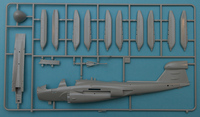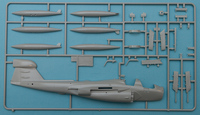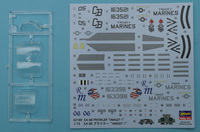
Hasegawa 1/72 EA-6B Prowler 'VMAQT-1'
By Chris Banyai-Riepl
Overview
The Grumman EA-6B Prowler evolved from the A-6 Intruder as a dedicated electronic warfare aircraft. From the 1970s until recently, the EA-6B was the primary electronic warfare aircraft of the US, operating with both the US Navy and US Marines. The EA-18G Growler has replaced the Prowler in the Navy with the last EA-6B flight taking place in 2015. The US Marine Corps will continue flying the type until 2019, when the Prowler will finally be retired from flying operations.

The Kit
This is the classic Hasegawa EA-6B Prowler kit, dating back to the early 1980s. While an older kit, it does feature recessed panel lines and quite a bit of detailing externally. Internally it's a bit weaker, though. Over the years this kit has been re-released with lots of decal options, and this one is the same story. For this release, there's a new decal sheet with a couple of Marine EA-6Bs.

Jumping into the build, the kit starts you off with the cockpit. You get a quartet of seats, a one-piece tub, a separate front instrument panel, and a separate piece dividing the front and rear cockpits. This was adequate for 1980, but it is sorely lacking in detail by modern standards and I highly recommend picking up the Aires cockpit set for this kit (which comes in both an early and late ICAP-2 configuration).
Once your interior is done, the fuselage can go together. This is split into a right and left half, with a separate lower fuselage insert to accurately capture the complex curves found on the underside. The intakes have separate pieces for the crew access steps, which is a nice touch. The nose is separate and has plenty of room for the extra weight you'll need to keep this on all three gear.

For the wings, these are simple upper/lower assemblies, with no extra fiddly bits to deal with. For those who want a clean build, that's all you'll want. For those who want to go the extra step, good luck, as folding the wings or dropping the flaps will be quite a chore on this plane. The joint between the wings and fuselage is clean and should result in no filler needed. The stabilizers show a similar pattern, with the stabs themselves as solid pieces and positive tabs forming the mounting structure.
Next up are the landing gear, and the struts are sturdy and well detailed, showing the beefy quality common to Grumman Navy aircraft. The nose gear is one piece with separate wheels, while the main gear has two separate struts as well as separate wheels. The gear doors for the main gear help hide much of the attachment points, which is good as the wheel well is pretty basic. The nose gear is a bit more open and as such it has more detail.

Moving on to the stuff hanging under the wing, the kit comes with a full assortment of ECM pods and fuel tanks. If you wish to load it full up, you can put five ECM pods on the plane: four under the wings and one under the centerline fuselage. Alternatively, you can add a centerline fuel tank and two wing tanks, or mix and match in any order you see fit.
The last bit is the canopy, which comes molded in clear. The real EA-6B Prowler had the canopy impregnated with gold to help protect the crew from the electromagnetic field, and this effect is not present in the kit. You will have to use your own technique to get this effect, and the best bet is to use something like Tamiya Smoke to tint the canopy.

For marking options, this kit comes with two low-viz Marine EA-6B Prowlers, one from VMAQT-1 and one from VMAQ-4. The VMAQT-1 aircraft is BuNo 163521, coded CB05. The VMAQ-4 aircraft is BuNo 163398 and is coded RM06. Both have standard camouflages of low viz grays, with the unit markings restricted primarily to the rudders. The decals are well printed and the only real challenge will be making sure that the grays you choose for your low viz scheme are different enough from the markings to ensure that they don't disappear on the kit.
Conclusion
This is still the best choice for a 1/72 EA-6B Prowler available, and with the addition of an aftermarket cockpit it will build up into a nice representation of this famous electronic warfare aircraft. My thanks to Hasegawa USA for the review copy.
